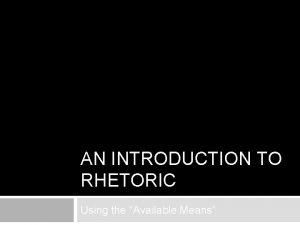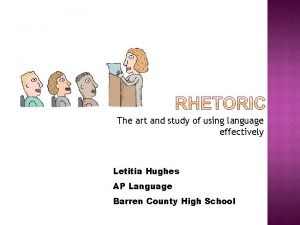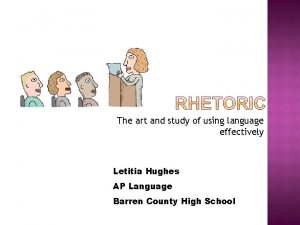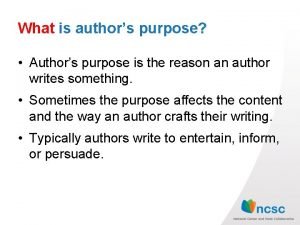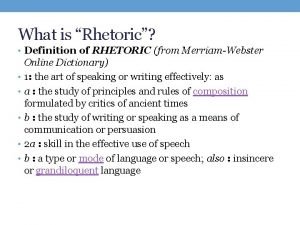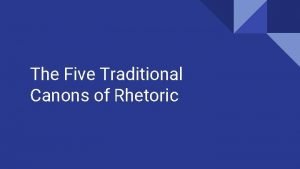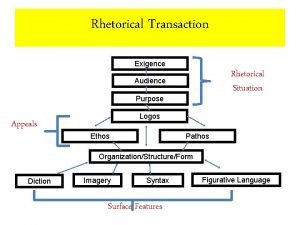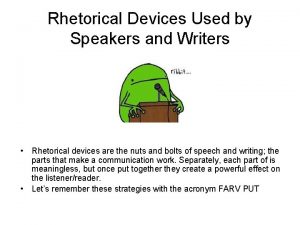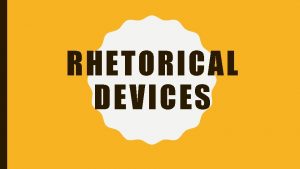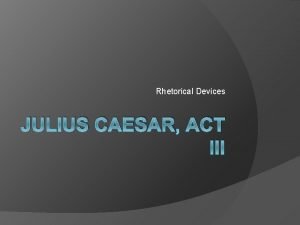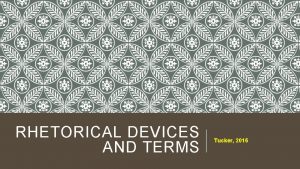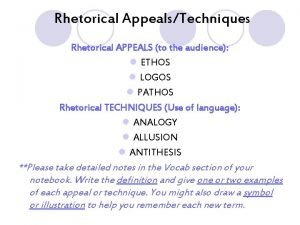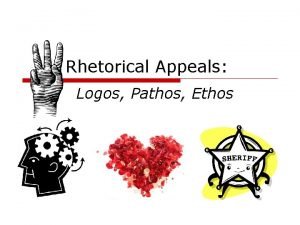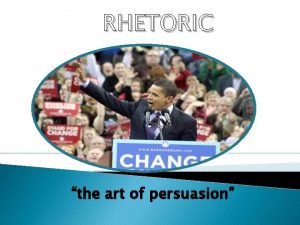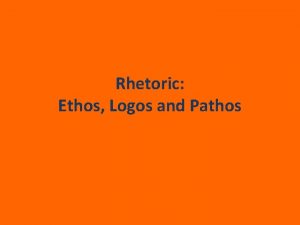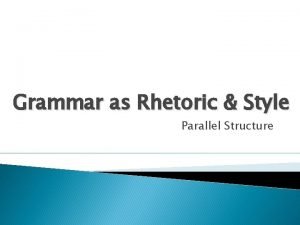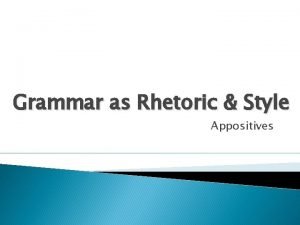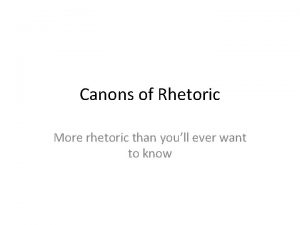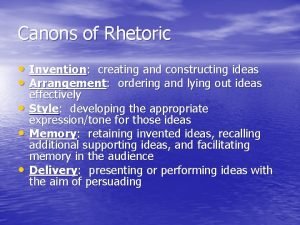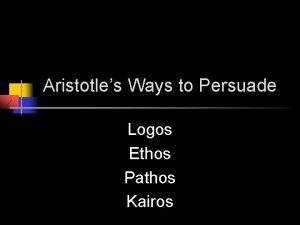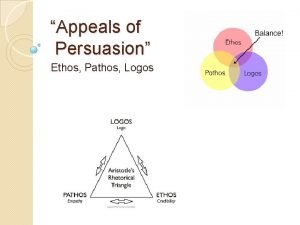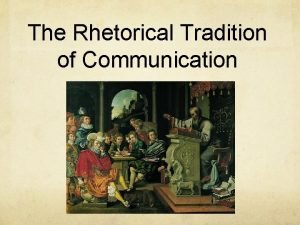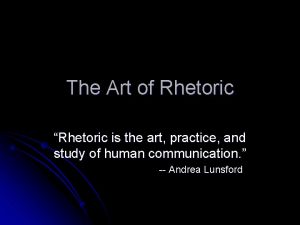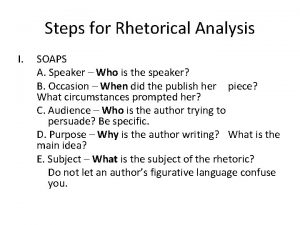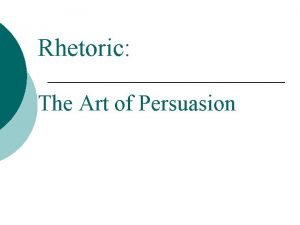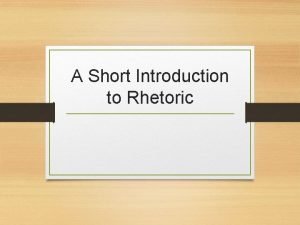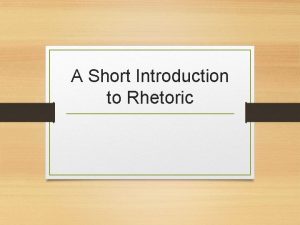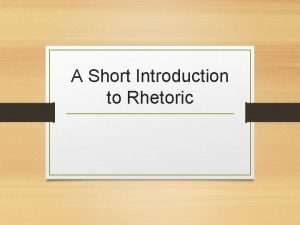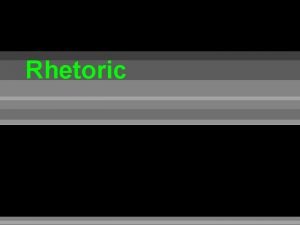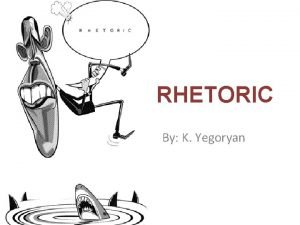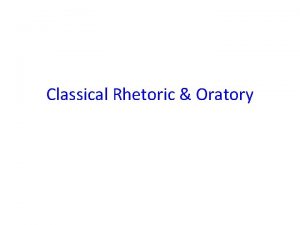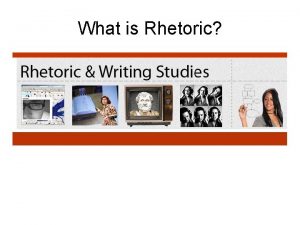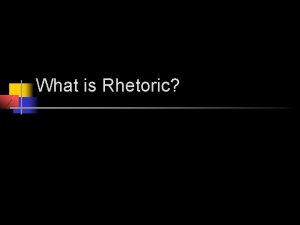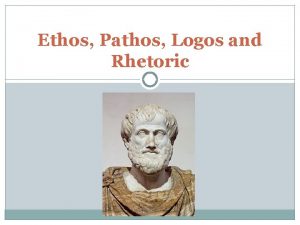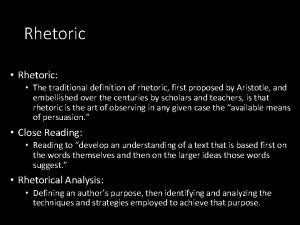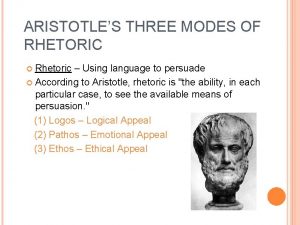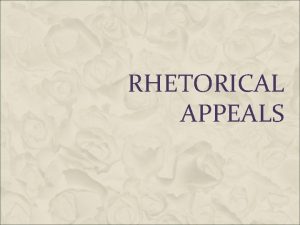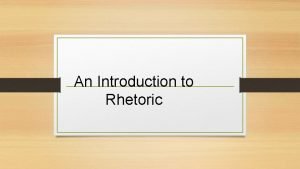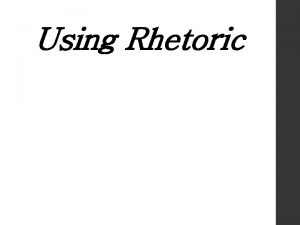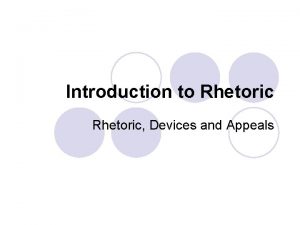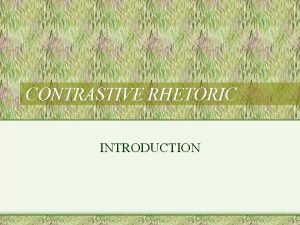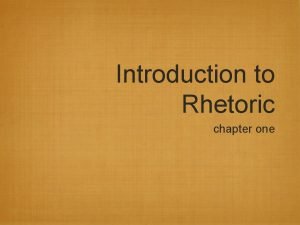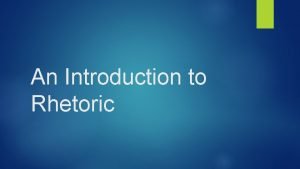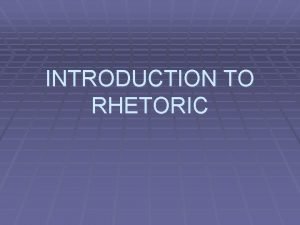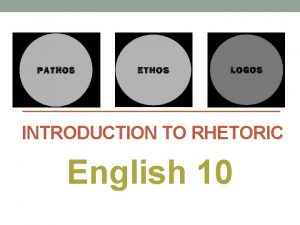An Introduction to Rhetoric is Using language effectively



































- Slides: 35

An Introduction to Rhetoric is: Using language effectively to persuade, inform, educate, or entertain Aristotle (384 -322 B. C. ) (Not Mr. Baker!) ut o h wit ade s t flic persu port n o e c n, to o sup v l o o “res ontati eners t move t to fr con rs or lis on, or n. ” iti tio de rea eir pos s to ac er th oth

Rhetorical Transaction Exigence Rhetorical Situation Audience Purpose Appeals Logos Ethos Pathos Organization/Structure/Form Diction Imagery Syntax Surface Features Figurative Language

Rhetoric Situation: The circumstances in which you communicate

The Writer • Your culture, personal characteristics and interests affect what you write about and how you write it.

Writer: Factors which can affect your writing include: • • Your age Your experiences Your gender Your location Your political beliefs Your parents and peers Your education

Purpose: Your Reason For Writing

Genre • Category or type of writing • Genres hinge upon purpose and the needs/expectations of the projected audience. • Examples: fiction, autobiographical story, news article, review, letter to the editor/editorial, rhetorical analysis, criticism, persuasive essay

Audience: To Whom are you Writing? • Many of the same factors which affect the writer also affect the audience – Age – Social class – Education – Past experience – Culture/subculture – Expectations

Topic: What you will write about • May be broadened or narrowed depending on the length of your writing and your interest • Topics should be appropriate to the rhetorical situation you are in

Context • The “situation” which generates the need for writing • Affected by the – Time period or timing – Location – Current events – Cultural significance

Rhetorical Situation • • • Writer Purpose Audience Topic Context Culture

What this means… • You need to be aware that a rhetorical situation exists every time you write. • You need to adapt your writing depending on your purpose and your audience.

The Rhetorical Triangle The interaction of these three elements “determines the structure and language of the argument. ” Audience Speaker (or writer) Exigence: an issue, problem, or situation that causes or prompts someone to write or speak. Subject (message)

The Rhetorical Triangle Speaker = text n o C al c i r heto Exigence: an issue, problem, or situation that causes or prompts someone to write or speak. Ethos R Pathos: Audience Subject = Logos

I’ve Got 5 On It: 5 Canons of Ancient Rhetoric Invention Arrangement Style Memory Delivery

I’ve Got 5 On It: 5 Canons of Ancient Rhetoric Invention • Coming up with ideas for writing • Ethos • Logos • Pathos

Ethos (Credibility), or ethical appeal: means convincing by the character of the author. Key words: Trust Respect Honesty Record Truth Believe Location of article publication Author as expert

Logos (Logical): means persuading by the use of reasoning. Use of Facts Use of Statistics Use of Evidence Use of Numbers Use of Inductive reasoning Use of Deductive reasoning How an argument is framed Analyze cause & effect Example: A Snickers bar has 280 calories and 30 grams of sugar; That’s not very healthy.

Pathos (Emotional): means persuading by appealing to the reader's emotions. Getting people to FEEL: * happy * sad * angry The Maki people of the South are known to be invading our towns! They are corrupting our children and taking our jobs!! Vote for me and I will eradicate this menace! a e r C A s te ! N IO T C

I’ve Got 5 On It: 5 Canons of Ancient Rhetoric Arrangement • What order to present ideas in • Organization

Classical Model of Arrangement (Organization) 1) Introduction 2) Narration 3) Confirmation 4) Refutation 5) Conclusion Draws the reader in; establishes ETHOS Factual info & background; LOGOS & PATHOS Proof that makes the case; LOGOS Addresses the counterargument; LOGOS Brings all ideas together; PATHOS & ETHOS

I’ve Got 5 On It: 5 Canons of Ancient Rhetoric Style • How to express your ideas • Diction • Syntax

Diction Vs. Syntax Diction Syntax • Word Choice • Sentence Structure • Tropes • Schemes • Figures of Speech • Parallelism • Effectiveness • Punctuation • Jargon, slang, • Inverted Sentences scientific, etc.

I’ve Got 5 On It: 5 Canons of Ancient Rhetoric Memory • Spoken Rhetoric • To speak extemporaneously

I’ve Got 5 On It: 5 Canons of Ancient Rhetoric Delivery • Spoken Rhetoric • To effectively use voice, gestures, text, and images.

Patterns of Development 8 major patterns Organize individual paragraphs or sections • Narration • Description • Process Analysis • Exemplification • Comparison & Contrast • Classification & Division • Definition • Cause and Effect Author’s Purpose Organize entire text

Narration 1) Tells story; recounts events; personal 2) Chronological (detail, pov, dialogue) 3) Craft story to support thesis 4) Often used as a way to enter topics 5) Draws a reader in

Description 1) Paints a picture with senses; details 2) Establishes mood/atmosphere 3) Empathy; connection to text

Process Analysis 1) Explains how something works 2) Clear and logical 3) Proper transitions 4) Concise verbs

Exemplification 1) Provides a series of examples 2) “Let me give you an example…” 3) Aristotle = Induction = series of examples lead to general conclusion

Comparison & Contrast 1) Analyze information 2) Similarities & differences 3) Subject by subject 4) Point by point

Classification & Division 1) What goes together & why 2) Categories…. to help readers see relationships between seemingly unrelated things

Definition 1) Established common ground 2) Identifies areas of conflict

Cause and Effect 1) Cause leads to an effect 2) Effect that results from a cause 3) Needs logic 4) “Why” in the title

Rhetorical Transaction Exigence Rhetorical Situation Audience Purpose Appeals Logos Ethos Pathos Organization/Structure/Form Diction Imagery Syntax Surface Features Figurative Language
 Introducing rhetoric using the available means
Introducing rhetoric using the available means What is the study or art of using language effectively?
What is the study or art of using language effectively? The art of the effective use of language
The art of the effective use of language What is an authors purpose
What is an authors purpose Visual rhetoric
Visual rhetoric What is rhetoric
What is rhetoric What is rhetoric
What is rhetoric 3 types of rhetoric
3 types of rhetoric Canons of rhetoric
Canons of rhetoric Is rhetoric an art
Is rhetoric an art Rhetorical stance
Rhetorical stance Exigence in literature
Exigence in literature Tricolon sentence examples
Tricolon sentence examples Define parallelism rhetorical device
Define parallelism rhetorical device Literary devices in julius caesar act 1 scene 3
Literary devices in julius caesar act 1 scene 3 Personification examples
Personification examples Rhetorical advertisement
Rhetorical advertisement Ethos
Ethos Rhetoric: the art of persuasive writing and public speaking
Rhetoric: the art of persuasive writing and public speaking Pathos logos ethos
Pathos logos ethos Pathos examples in real life
Pathos examples in real life Anadiplosis examples
Anadiplosis examples Parallel structure rhetoric
Parallel structure rhetoric Appositive rhetorical definition
Appositive rhetorical definition What is esp
What is esp Canon of rhetoric
Canon of rhetoric Canons of rhetoric
Canons of rhetoric Kairos pathos logos ethos
Kairos pathos logos ethos Detente apush
Detente apush Logos pathos ethos
Logos pathos ethos Whats logos in writing
Whats logos in writing Purdue owl visual rhetoric
Purdue owl visual rhetoric Rhetorical tradition of communication
Rhetorical tradition of communication Rhetoric is the art of
Rhetoric is the art of Soaps rhetoric
Soaps rhetoric Rhetoric the art of persuasion
Rhetoric the art of persuasion
